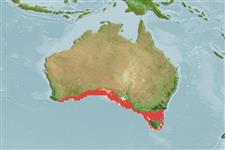Elasmobranchii (hajar och rockor) (sharks and rays) >
Orectolobiformes (Carpet sharks) >
Parascylliidae (Collared carpet sharks)
Etymology: Parascyllium: para (Gr.), near, i.e., presumed to be related to Scyliorhinus (now in Scyliorhinidae): skylion, Greek for dogfish or small shark (See ETYFish); ferrugineum: Latin for rust-colored, referring to dark brown spots on sides and fins (See ETYFish).
Environment: milieu / climate zone / depth range / distribution range
Ekologi
marina bottenlevande; djupintervall 5 - 150 m (Ref. 6871). Temperate; 31°S - 45°S, 117°E - 149°E (Ref. 54700)
Eastern Indian Ocean: endemic to Australia.
Length at first maturity / Size / Vikt / Age
Maturity: Lm ?, range 60 - ? cm
Max length : 80.0 cm TL hane/ej könsbestämd; (Ref. 6871)
Found on the continental shelf; on or near the bottom; also close inshore near rocks and river mouths. Occurs on beds of algae on reefs or seagrass; also hides in rocky caves and ledges during the day. Feeds on bottom-dwelling crustaceans and molluscs (Ref. 43278). Oviparous (Ref. 6871, 43278).
Life cycle and mating behavior
Könsmognad | Reproduktion | Lek | Ägg | Fecundity | Larver
Oviparous, paired eggs are laid. Embryos feed solely on yolk (Ref. 50449).
Compagno, L.J.V., 1984. FAO Species Catalogue. Vol. 4. Sharks of the world. An annotated and illustrated catalogue of shark species known to date. Part 1 - Hexanchiformes to Lamniformes. FAO Fish. Synop. 125(4/1):1-249. Rome, FAO. (Ref. 247)
IUCN Red List Status (Ref. 130435: Version 2024-1)
Threat to humans
Harmless
Human uses
Fiskeri: saknar intresse
Verktyg
Special reports
Download XML
Internet-källor
Estimates based on models
Preferred temperature (Ref.
123201): 14.6 - 18.3, mean 16.8 °C (based on 158 cells).
Phylogenetic diversity index (Ref.
82804): PD
50 = 0.5352 [Uniqueness, from 0.5 = low to 2.0 = high].
Bayesian length-weight: a=0.00389 (0.00180 - 0.00842), b=3.12 (2.94 - 3.30), in cm total length, based on all LWR estimates for this body shape (Ref.
93245).
Trofisk nivå (Ref.
69278): 3.7 ±0.6 se; based on size and trophs of closest relatives
Resiliens (Ref.
120179): Låg, lägsta populationsfördubblingstid 4,5-14 år (Fec assumed to be <100).
Fishing Vulnerability (Ref.
59153): Moderate to high vulnerability (52 of 100).
Nutrients (Ref.
124155): Calcium = 13 [3, 58] mg/100g; Iron = 0.259 [0.069, 0.730] mg/100g; Protein = 18.8 [16.7, 20.8] %; Omega3 = 0.412 [0.185, 0.897] g/100g; Selenium = 11.8 [3.6, 31.5] μg/100g; VitaminA = 10.5 [3.3, 31.9] μg/100g; Zinc = 0.442 [0.215, 0.796] mg/100g (wet weight);
